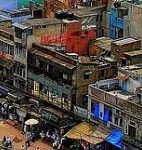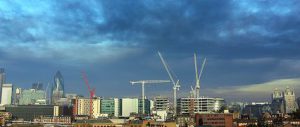Kristina Hill chairs the landscape architecture department at the University of Virginia.
Jared Green: Climate change is expected to cause mass migrations of animal and plant species. What design solutions can aid migration?
Kristina Hill: The most important planning and design strategies for biodiversity involve first protecting the land that has been conserved to date in two ways. Number one, by adding buffer zones to their edges, within which development is restricted or prevented. This is especially important on northern-aspect slopes, where characteristic regional species are more likely to persist in an era of increasing dryness and temperature extremes. Second, educating the public about the importance of reducing the negative impacts of what landscape ecologists call “the matrix” – which includes all the developed landscapes outside the reserves.
This is a strategy ecologists sometimes call “reducing matrix hostility”. It basically means that even developed landscapes can contribute to the overall ability of a region to support sensitive species that lived there before development occurred. When each developed parcel manages the quality and quantity of its storm-water runoff, for example, it contributes to a healthier landscape with sustained regional biodiversity. Improving air quality can make it possible for insects to locate and pollinate plants in developed landscapes. Reducing noise on roadways can benefit frogs that use sound in mating behaviour in wetlands nearby. Building wildlife over- and under-passes can allow animals to migrate and disperse through heavily developed landscapes.
In addition, climate change creates an imperative to add corridors and stepping stones at all spatial scales. As the ecologist Stuart Pimm has pointed out, it’s more efficient for species to move up by hundreds of feet of elevation as a way of staying cooler than it is to move tens or hundreds of miles north to get the same benefit. But going up in elevation is like walking the plank, because it means there is less area available as the species go up and the solution is limited by the maximum height of the hills or mountains available.
The biggest questions involve timing. If species characteristic of a region start to die out, will species that could survive the new seasonal conditions be able to get there, find suitable locations, and successfully reproduce before they die out in their own regions? When will the species that are their food be available locally? When will new predators, parasites and competitors also move in? It’s a very complicated four-dimensional chess game.
JG: In downtown Chicago and other cities, coyotes and other wildlife have been found digging through dumpsters in the subway and inside supermarkets. What kind of designs can aid animals that have taken up urban living because of changes in their natural environments?
KH: That’s an interesting question, from a strategic point of view. Species that are already thriving in urban environments or begin to do so in the future may not need our help, since they are finding ways to survive by themselves in human-dominated environments. They may, however, provoke new attitudes, ethical debates and management relationships. I think that’s the really interesting part – will our cultural attitudes towards these animals change? Perhaps even our sense of what it means to be human among other species may change. What would happen if an animal that represents a threat to our children becomes able to thrive in urban areas?
Coyotes are probably expanding their urban populations not just because of lost habitat outside cities, although that may be a factor in some areas, but also because of changes in their behavioural traits. They are becoming habituated to human presence as they increasingly subsist on a diet of wasted human food and cats. Juvenile animals learn from their mothers and their peers how to find food and den sites, and what dangers to avoid. They’re also learning that toddlers are not dangerous, and may be prey. Over the next few decades, we may have to learn to design deterrents and exclosures – fences or something equally effective — that keep coyotes out of areas where small children play, rather than design habitat for coyotes in cities. We may eventually even need to hunt coyotes to keep their urban populations small, and remind them that humans should be avoided.
Will urban people learn new things about their relationship to other species? It’s hard to fully appreciate how much that could change our self-image as urban people, over a long period of interaction.
JG: Storm-water overflow from cities presents a major problem for natural fish habitat in surrounding areas. You have cited projects in Seattle that can help ensure fish eggs don’t get flushed away during rainstorms. How can infrastructure be designed to be wildlife-friendly?
KH: Before I give examples to answer this question, I want to point out that “infrastructure systems” include the point-of-use of resources (inside buildings, for example, where electricity is consumed) in addition to the transmission networks that convey resources from a place of abundance to a place of scarcity in relation to demand. These systems also include the landscapes that support the place of abundance, both inside and outside urban areas, headwaters and tributaries that drain to reservoirs, for instance. Our focus on the networks for conveyance – pipes, overhead powerlines, highways and seawalls – when we conceive of infrastructure has drastically reduced our ability to imagine options for making cities and their supporting regions more resilient.
If infrastructure projects protect vulnerable people – especially poor families – and special places, like north-facing slopes, or headwaters of stream systems or estuary “nurseries” for fish and shellfish, that’s the first performance issue. The second is that these projects should contribute to the renewal of basic resources (soil fertility, air quality, water quality, etc.) and not reduce the supply of these. Finally, the third is that they should contribute to re-tooling our ways of moving things around, so that we are more resilient to extreme environmental events and increasing fuel costs.
Transit, parks and new shoreline structures that provide habitat while protecting property and utilities all look like better investments using the criteria I’ve noted above. To me, being “wildlife-friendly” isn’t the point – it’s about supporting ecosystem resilience, with humans recognised as an integral component of those ecosystems. Empirical observations and models support the conclusion that many species will become extinct or rare because of climate disruptions and increased urbanisation over the next several centuries, no matter what designers do today. The real trick is to act ethically as human beings in the midst of those larger trends, advocating to protect what we can and increase our ecosystem-level resilience over time.
The port of Antwerp [in Belgium] has implemented a strategy that provides an interesting example for infrastructure and wildlife. Biologists and planners collaborated there to identify a “habitat backbone” system of permanent wetlands to support habitat for natterjack toads. But they added the idea that port landscapes with shifting, temporary uses can also play an important role in providing temporary habitat, as part of what landscape ecologist Richard Forman once called the “shifting mosaic” of a landscape. It’s possible that many other species could be supported in and around urban areas by providing both a core habitat area and temporary zones available in different seasons or in different years.
The Bay Area Conservation and Development Commission in San Francisco is studying ways to respond to increases in sea level while supporting species that live in the Bay, using a mix of artificial marshes and hardened shoreline structures. The Dutch are experimenting with a strategy they call the “sand motor”, in which they would place dredged sand in an artificial mini-peninsula along their coast and allow the processes of wave action and along-shore currents to redistribute it as massive sand dunes to protect their coast. I believe that this sort of “cyborg landscape” strategy, combining artifice and natural processes, holds the most promise for supporting biodiversity while achieving human goals – not the least of which might be gaining an aesthetic that appreciates processes and change. If humans see change as beautiful, adaptation will be easier.
Jared Green is web content and strategy manager at the American Society of Landscape Architects.
This interview was first published by the American Society of Landscape Architects. It is reproduced here with permission.
Part one: preparing cities for climate extremes
Homepage image by Rob John MacKenzie


